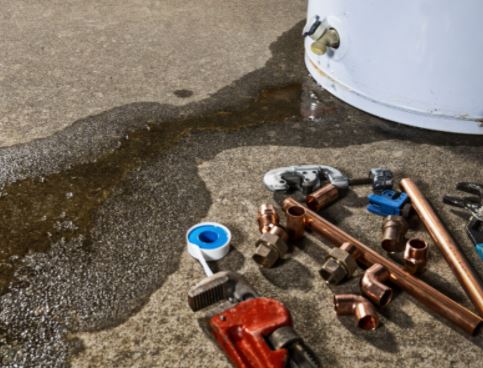Good Day! WARNING drinking/cooking/brushing your teeth with warm/hot water from your water heater or just taking a normal hot shower could compromise your health! Read on for details…
Our “heated” topics we are addressing today are about the potential harm and unhealthy consequences for your body using warm or hot water (other than showering and washing hands) for cooking, drinking or even brushing your teeth! We also want to address possible consequences of your hot water tank BACTERIA laden sediment being a potential breeding ground for Pontiac Fever or worse – Legionella (see electron-microscope image) that could affect the lungs of older immune-compromised adults.
A lot of homeowners probably don’t even give it a second thought when they turn on a single handle faucet before going to bed for the night – maybe you may casually turn the faucet handle to the middle position to brush your teeth with warm water or you don’t want to drink from the cooler water side as you quench your nightly thirst. Some serious unhealthy consequence could happen sooner or later if a conscious effort is not made to use only COLD water for the above actions. You see a water heater is like a catch-all for anything coming through your main water line. From the protective anode rod in your water heater that slowly deteriorates as it protects your glass tank lining from failing to incoming sediment and additive / by-product chemical reactions from the cities chlorine disinfection process. Water heater sediment is a “breeding ground” for corrosive Anaerobic Bacteria (please see our attached disturbing end of life WH draining pics) which you don’t want to assume will stay stagnant as you draw from the hot side of your faucet. Look at this list of inorganic source contaminates, water additives and by-products which are part of Chicago’s modern day municipal water system (From City of Chicago Water Management)

Inorganic Contaminants:
Barium
Nitrate
Total Nitrate/Nitrite
Radioactive Contaminants:
Combined Radium and Gross Alpha (excluding radon and uranium)
Unregulated Contaminants:
Sulfate
Sodium
Copper – the erosion of natural deposits-corrosion household plumbing products
Lead-corrosion of household plumbing systems
Regulated Contaminants, Additives/Treatment for Chicago’s Water Treatment System and the Homeowners integral WH anode rod:
Chlorine water treatment
Fluoride water treatment
Polymers – for coagulation to settle out impurities
Aluminum Sulfate – for coagulation, to settle out impurities
Blended polyphosphate – to coat pipes and prevent lead leaching
Activated carbon – remove unpleasant tastes and odors
Water Heater Anode Rod – deterioration of magnesium, aluminum, zinc as it sacrifices itself to protect glass lining of water tank.
By-Products of above disinfection additive (i.e. chlorine):
Trihalomethanes – demonstrated carcinogenic activity in lab animals
Haloacetic Acids – demonstrated carcinogenic activity in lab animals (has seen to cause bladder cancer, rectal and colon cancer)
∙ All above combined represent your typical sludge /sediment accumulation in the bottom crevices of your water heater. Although chemical amounts are small – about a teaspoonful for every 100 gallons. Realize you have to take into account years of accumulation settling in the bottom of your water heater. The same thing happens in the huge outdoor elevated storage tanks that dot city skylines. These giant tanks help buffer high demand periods of a cities water use. Large amounts of potentially harmful sediment 6” + accumulations are not unheard of in side these storage tanks over the years. Many of these elevated tanks are actually cleaned while staying in service – by sanitized scuba divers!
Addressing our 2nd issue legionella contamination as mentioned above, we will now describe how your water heater could potentially be harboring legionella bacteria. Legionella bacteria is found naturally in water and thrives in a warm environment and on a food sources such as accumulated water heater sediment. Legionnaires disease, is a lung disease and has a specific form of pneumonia that can require hospital treatment. The vulnerable, compromised immune systems of older people are at most risk and they can contract the infection simply by breathing in contaminated hot water droplets – something that might happen when taking a simple shower. Legionnaires disease and Pontiac fever are collectively known as legionellosis, a disease caused by legionella bacteria. Legionnaires disease is a serious potentially deadly, lung infection (i.e., pneumonia) and Pontiac fever is a less serious infection with milder symptoms similar to the flu. Many of the older population getting sick with “Pontiac Fever” fly under the radar with mild flue symptoms. OSHA estimates that between 8,000 to 18,000 Americans are hospitalized each year with legionnaires disease. Also since patients with Pontiac Fever usually get better on their own, cases may not be routinely recognized or reported as contracted legionella. (OSHA.GOV).

In a Canadian water heater study (Epidemiology & Infection, Volume 140, Issue 1, January 2012) on where legionella showed higher frequency, legionella was found to be more prevalent in electric units because there heating elements are located on the side vs gas WHs where the heating source is at the bottom. The Canada water heater study of 211 homes of which 178 had electric water heaters. The study found that 69 of these homes or 33% harbored legionella. None were found with gas heaters. To kill possible legionella formation the water temperature of any WH tank must be raised to a minimum 140 degrees which can kill legionella in 32 minutes. (At 160 degrees it’s less than 2 minutes). So how do you balance scalding hot water to kill legionella vs water safety? Well first off if your water heater is 8-10 years old (out of warranty) it would be better to replace the appliance and if you want to eliminate bacteria laden sediment altogether, go tankless! Also, if you were wandering if flushing the tank will help – don’t waste your time as standard tank water heaters weren’t designed to effectively get rid of accumulated sediment. If your tank is less than 6 -7 years old or are replacing with a new tank, Berner Plumbing & H20 would Install a new Thermostatic Booster valve on the top hot/cold connections of your water heater – (See Pic) Thermostatic technology has been around for over 100 years and has proven its tempering hot water safety reliability. Adding a Thermostatic Booster mixing valve to a water heater allows water to be stored at a higher temperature but safely delivered at 120 degrees to all outlets. The valve mixes both hot and cold water which increases the tanks water capacity – thereby also reducing the chances of Legionella growth by allowing the thermostat to be set at 140 degrees. A booster thermostatic valve also has the added advantage of increasing an electric WH capacity by 42% and a gas WH capacity by 51%!

Thanks as always for reading and please feel free to comment on our latest Blog 104 and see you on the other side!



